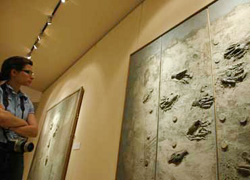
Xu Jiang believes that artists should look themselves in
retrospect from time to time while venturing into new
territories.
"In so doing, one can really learn something from past
experiences," said Xu, artist and president of the Hangzhou-based
China Academy of Art in East China's Zhejiang Province.
Xu is sharing his own retrospective show entitled "Vistas,"
which is being held at the National Art Museum of China in downtown
Beijing until Thursday.
"Generally speaking, artists would not stage their 'retros'
until they admit they are really old enough and that their pursuit
for artistic achievement has run out of steam," said the
51-year-old.
"For me, a retrospective show is but a summary for a particular
paragraph in my artistic life that is still expanding."
Born in 1955 in East China's Fujian Province, Xu was educated at
the Oil Painting Department of China Academy of Art in the early
1980s and served as a research fellow at the Free Arts Department,
Hochschule fur Bildende Kunste, in Germany from 1988 to 1989.
Beijing-based art critic Yin Shuangxi said that "in a globalized
world, Chinese artists are increasingly aware of the importance of
finding their identity and cultural roots.
"Xu and his art vividly showcases Chinese artists' changing
attitudes toward the influences of Western art trends over the past
two decades."
At the opening ceremony of his art show last Thursday, the
artist likened himself to "a traveller coming a long way back
home," referring to his shift from creating trendy installations
and mixed media works over 15 years ago to exploring the new
possibilities of "traditional" art forms such as watercolour,
Chinese ink painting, and oil painting on canvas in recent
years.
At least 200 selected pieces of watercolour and oil paintings
depicting poetic imageries of Chinese and European cities such as
Shanghai, Beijing and Berlin make up Xu's solo art show, which
examines his artistic odyssey since the early 1990s.
The exhibition is divided into three parts "Chess Match of the
Century," "Historic Landscapes" and "Syncopated Vistas."
Xu is keen on drawing from Chinese culture, as is illustrated in
his "Chess Match of the Century" series from 1996-1998.
With a symbolic and poetic touch, these early works depict
bombarded buildings, ruins of old Chinese palaces and collapsing
monumental structures.
The chess game reference is taken as a symbol of history, as the
Chinese saying goes, "Events (that) happened in three dynasties can
be observed in a chess game," wrote art critic Shui Tianzhong in
the catalogue to the exhibition.
In the "Historic Landscapes" series, viewers will find
awe-inspiring images of cityscapes, rough mountains and villages
that are depicted as if being viewed from the sky.
Xu is primarily recognized as a landscape painter. However,
"unlike other artists specializing in either cityscape or natural
scenery, Xu paints both subjects with equal eloquence," said Fan
Di'an, director of the National Art Museum of China.
"Xu's penchant for cultural and historical richness of the city
finds vivid expressions in his watercolour or ink paintings. His
cityscapes with compelling imageries of skylines, streets and
buildings recall a tragedy or epic," Fan said.
In the third part of the exhibition, Xu presents several
painting series he has been working on since 2003, among which are
"Twelve Views of Sunflower Fields," created earlier this year and
"Black Tiles, White Tiles," a series of Beijing's hutong and older
areas. That series won second place at last year's Beijing
International Art Biennale.
The imageries of sunflowers and reeds appear again and again in
his "Vistas" series.
"Often placed in a desolate setting, they might be read as
symbols of the resilience and strength of life that fights against
passing time," said art critic Shui Tianzhong.
The vividly portrayed, maturing sunflowers are eventually
transformed into a vehicle of cultural and historical meanings,
Shui explained.
In his view, Xu's early works bear a strong influence from
contemporary Western art.
But his latest works such as the "Sunflower Fields" paintings,
demonstrate the artist's return to his cultural roots.
(China Daily June 20, 2006)
|

